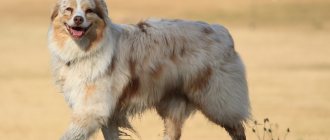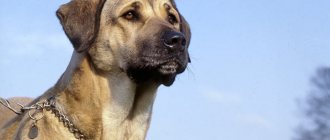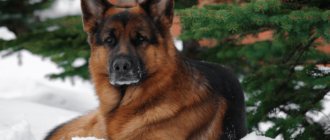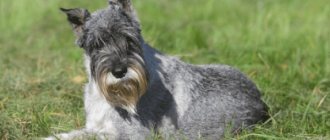Looking at these animals, it is impossible to take your eyes off, because the Aussie Australian Shepherd simply fascinates with its unusual appearance and the penetrating gaze of its delightful bright eyes. But before you get an Australian, you should learn everything about the breed, since there are many nuances in keeping these dogs and they are not suitable for everyone.
Australian Shepherd: brief characteristics of the breed
Aussies were originally bred as a herding dog breed, but they became most popular as family pets and loyal companions. Australians are extremely sociable, friendly and peaceful animals. Aussies are not aggressive and get along well with all pets. Among Australian Shepherds, there are often individuals with heterochromia, when the dog's eyes have different colors, for example, one is blue and the other is brown. This breed has pronounced sexual dimorphism, thanks to which you can easily distinguish a female from a male. Australian Shepherd females reach smaller sizes and have a more graceful physique. Aussies are active and energetic dogs, so they are suitable only for people leading an active lifestyle.
Among Australian Shepherds there are individuals with different eye colors.
Pros and cons of the breed
| Advantages | Flaws |
| Friendly character | High activity |
| Spectacular appearance | Heavy shedding |
| Compatible with other pets and children | Intolerance of loneliness |
| Performance | |
| Sensitivity to the owner's mood | |
| Good intellectual abilities |
The Australian Shepherd is beautiful, intelligent and loyal. This is an excellent companion for a person leading an active lifestyle, and a good assistant for farmers raising livestock.
This affectionate and friendly pet, with proper training, can also successfully perform the duties of a service dog and guide dog. And with proper care and attention to the pet, it will please its owner and serve him for a long time.
Aussie Origin History
These beautiful and strong animals are known as Australian Shepherds, but in fact their homeland is North America.
It was thanks to the efforts of American breeders that the Aussie breed was born, which has an original appearance, amazing endurance and performance.
At the end of the nineteenth century, the active development of cattle breeding began in America and not only European, but also Australian shepherds began to flock to the New World. Naturally, they came accompanied by their faithful dogs, and local cattle breeders appreciated the working qualities and physical potential of these animals.
Farmers have decided to use imported dogs to breed a new breed that would combine all the positive traits of their parents. The best representatives of Basque (Pyrenean) Shepherds, Collies and Bernese Mountain Dogs were selected for selection. As a result of painstaking work, a completely new breed of dog appeared, which was given the name Australian Shepherd, or Aussie for short, associating them with shepherds from the Australian continent.
Very soon, the smart, intelligent and active Aussies began to be used not only to guard livestock, but also in equestrian competitions and rodeos, where they entertained spectators with amazing abilities and funny tricks. During the First World War, Australian Shepherds provided invaluable assistance to American soldiers, acting as messengers.
The Aussie was first registered as a herding and working dog in 1957. But the official recognition of the Australian Shepherd by all canine organizations occurred only at the beginning of the twenty-first century.
Australian Shepherd: description of the breed
Aussies are medium-sized dogs, strong and robust. The height of Aussies varies between forty-five and sixty centimeters. Adult Australians weigh from twenty to forty kilograms.
Appearance of an Australian Shepherd
External characteristics of the breed:
- Animals have a proportional build, the body is flexible and muscular;
- paws are straight, of medium length with oval pads;
- Aussie puppies are born with a short tail and if it is not docked, then in adult dogs it reaches a length of up to ten centimeters and is covered with long hair. But, as a rule, the animal’s tail is docked, leaving a short stump, the so-called “bobtail”;
- Australians have a large head extended towards the nose;
- medium-length ears have a triangular shape;
- Aussies have expressive almond-shaped eyes. Eye color can be bright blue, green or light brown;
- Dogs' fur is long and thick with a dense undercoat. The hair on the head, ears and front legs is shorter than on the rest of the body.
Important: there is a variety of the Australian Shepherd - mini-Aussie. Miniature Australians differ from their larger relatives only in size. The height of the dogs ranges from thirty to forty centimeters, and the weight of the mini-Aussie does not exceed twenty-five kilograms.
On the left in the photo are two representatives of mini-Aussies, on the right are two representatives of Aussies
Tips for choosing a puppy
Seek advice from professionals: a specialist consultation will guide you on the price and characteristics of the animal.
Healthy Aussie puppies resemble a plush toy, and their fur is free of bald spots and tangles. Examine the abdomen - the skin should be clean, without rashes or hernias.
Clubfoot in babies is a sign of defective breeders from the breeder, so decide for yourself whether to take a dog with deviations from the standards, and at a rather high price.
Choose trusted breeders, and watch videos and pictures of puppies before your trip. Learn about screening dogs for eye and other diseases.
Aussie colors
Australian Shepherds come in a variety of colors and patterns. The uniqueness of these dogs is that no two Aussies are alike; each has its own unique coat color and body pattern.
The breed standard allows four color options.
Black
The main color of the dogs is black, but red and white markings are acceptable.
Australian Shepherd black color
Red
The body of the Aussie is colored fiery red, sometimes interspersed with white.
Red Australian Shepherd
Blue marble (merle)
The main color of shepherd dogs is gray-blue with a silver tint, interspersed with black, red and white spots intertwined into a bizarre pattern.
Blue merle Australian Shepherd
Red marble
The dogs are colored red or copper-red, and have black and white spots of different sizes and shapes scattered across their bodies.
Red marbled Australian Shepherd
Character and behavioral characteristics
Affectionate, loyal, sociable and extremely cheerful dogs, and this is not the entire list of positive qualities of Australian Shepherds. Aussies are considered versatile four-legged pets, they are ideal companions, excellent guards and loyal loving dogs that can, without exaggeration, be called part of the family.
These amazing animals have irrepressible energy, they are cheerful and active and are in constant motion. Aussies will never sit in one place; these dogs are constantly busy with some business or work that is important from their point of view. Sometimes it seems to owners that their pets never sleep, because they react to the slightest rustle and any extraneous sound.
The Aussie will happily spend time playing with his owner, accompany him on a morning run, or join him on a bike ride. And if the owner is busy, the hardworking pet will keep himself busy patrolling the area, playing with a ball, or looking after domestic animals such as rabbits and ducks.
Aussies are real fidgets that are suitable only for very active owners.
The Australian Shepherd sincerely loves all family members, but it is the owner who is the center of the universe and the undisputed leader for the dog.
An Aussie always strives to please its owner, and nothing is more important to her than his approval and attention. In the morning, the dog will accompany the owner to the gate and will impatiently await his return. And in the evening he will be the first to meet his beloved owner from work, squealing loudly with joy, wagging his short tail and baring his teeth in a welcoming smile. A dog accurately guesses a person’s mood and adapts to it. The Aussie will share joy with the owner and will be sad in solidarity with him if he is upset or upset about something.
Aussies are very sensitive to the mood of their owner, they can empathize and rejoice with him
Australian Shepherds are responsible, reliable and vigilant guards. Yes, they are friendly and peaceful, they are not characterized by aggression and anger, but this does not mean that animals cannot stand up for themselves or protect their family. Aussies will cope with any assignment of the owner, because for them there are no impossible tasks. Australian Shepherds can be safely trusted to guard your home and surrounding area. They will take care of the safety of a small child, not allowing him to leave the yard and not allowing strangers near the baby. Australians will look after a flock of sheep, goats and cows, and will not allow the animals to run away or stray from the herd.
Representatives of this breed have a stable and balanced psyche, but at the same time they are very emotional and express all their feelings with the help of their voice and various movements. In general, these animals do not tend to vocalize for no reason, and the Australian will not disturb the night's sleep of household members simply because he is bored and wants to attract attention to himself. And if a dog in the yard begins to bark loudly, this means that it has noticed something suspicious and is in a hurry to warn the owner about it. Also, with a loud, loud bark, the vigilant pet will notify the owner of the arrival of guests.
The Aussie breed is distinguished by high intelligence; they are quick-witted and observant, thanks to which they are able to find a way out of any situation.
These insightful and intelligent animals carefully analyze everything they see and hear and instantly find a solution to even the most difficult problem. Australian owners are always surprised how their pet disappears from a locked room or manages to escape from the yard. And everything is very simple - the Aussie carefully watches the actions of the owner in order to repeat them later. Therefore, it is not a problem for a dog to turn a doorknob or open a fence gate to sneak out for a walk. By the way, opening the door of the refrigerator or bedside table to get to your favorite treat is also not difficult for your smart pet.
Australian Shepherds are highly intelligent and castles are not an obstacle for them.
With strangers, the Australian Shepherd behaves warily, but politely. The dog will not take his eyes off the stranger, while keeping a respectful distance. But the Aussie is friendly towards the owner’s friends who often visit their home and greets them with a friendly bark.
Important: Australians are very sensitive to the mood of all household members. They cannot stand quarrels and scandals; it is very important for them that peace and harmony reign in the family. In the event of a conflict between household members, the Aussie will act as a diplomat, running from one family member to another, inviting them to a conciliatory dialogue.
Aussie puppies: maintenance and training
Fluffy and cute Australian Shepherd puppies look like little plush toys. And it is not surprising that the charming baby becomes everyone’s favorite from the first minutes of his appearance in the house. A perky, cheerful and inquisitive puppy will immediately get to know all family members, explore all the rooms in the house and explore the surrounding area.
The little Australian shows a keen interest in all surrounding objects, often tasting them. Therefore, on all things that come into the field of view of a curious pet, traces of his teeth may remain. To protect valuable items from the puppy, they should be hidden in a place inaccessible to him, offering the pet a variety of toys in return, including chewing ones.
When purchasing an Aussie puppy, be prepared for surprises in the form of damaged things and furniture.
In addition, you should teach your child discipline from early childhood and devote time to his upbringing. It is especially important to teach your puppy commands such as “fu” and “no”. It is unacceptable to cruelly punish a puppy for a chewed shoe or a puddle in the wrong place. After all, a severe reprimand is enough for a smart pet to realize his guilt and not do it again.
It is very interesting to watch how an Aussie puppy develops protective instincts from a young age. For example, a baby loves to collect all his toys in one pile and zealously protects them from other pets. Also, the little Australian will readily take on the role of a guardian of small animals, making sure that chickens or rabbits do not escape from the yard.
The puppy needs constant attention, communication and interaction with people. Therefore, it is necessary to work with your pet every day, teach him commands in a playful way and do not forget to praise him for his obedience and intelligence.
Raising and training a puppy will take a lot of time and effort from the future owner, since Aussies are very attached to their owner and require attention
Attitude towards children
Aussies have a particularly reverent and tender relationship with children. These beautiful and loyal animals can be owned by families with a child of any age. After all, Australians are very patient, affectionate and careful, and even during active play they will never harm a baby.
The Australian Shepherd has a very stable psyche, so it is not capable of harming a child.
For a small child, the Aussie will become a caring and responsible nanny. The dog will make sure that the baby does not leave the territory of the house and will not allow a stranger to approach him. The pet will calmly accept the fact that a child can pull it by the tail or squeeze it in a tight hug without showing even a shadow of dissatisfaction.
An Australian Shepherd will be a cheerful friend and active play partner for a schoolchild. In the morning, the Aussie will walk the child to the school gate, meet him after school and enthusiastically play football with him or take a walk in the park.
An Australian will be an inseparable companion for a teenager, especially if he plays sports. A hardy and strong dog will run a multi-kilometer cross-country race with him, take part in a bicycle race and accompany him on a hiking trip.
Aussie will monitor the child so that he does not leave the yard
Important: Aussies have one interesting feature: in order to return a lost sheep back to the herd, the dog bites its hind limb. A pet can behave the same way with a baby, so you should immediately explain to the dog the rules for interacting with a child.
Relationships between Aussies and other pets
Australian Shepherds are a breed of dog that gets along well with all pets. In the eyes of an Aussie, another dog or cat is not a rival, but another family member and friend to play with.
A friendly and cheerful Australian will find a common language with almost any non-aggressive dog, be it a miniature Yorkshire terrier or a strict German shepherd. But keeping Aussies with dog breeds such as the Caucasian Shepherd or Rottweiler is not recommended, as they are jealous of their own territory and do not tolerate the presence of other animals in the house. And although Australians do not tend to show anger and hostility, and Aussies will never be the first to provoke a conflict, they will not run away from a fight and will be able to stand up for themselves. Therefore, a clash between two four-legged pets can end disastrously for both parties.
Aussies get along very well with other pets and do not have a hunting instinct for small pets.
Australian Shepherds are loyal and peaceful towards cats and will not even touch the neighbor’s cat if it wanders into their territory. Warm, friendly relationships are often established between an Aussie and a furry pet; the two of them play and play pranks and even sleep together. But even if the cat does not like the annoying attention of an active and restless Australian, the dog will not impose his company on her, they will simply live peacefully in the same house, without showing anger or aggression towards each other.
As for small pets, Australian Shepherds completely lack the hunting instinct, so you can safely get a decorative rabbit, chinchilla or hamster without fear for their safety.
Breed traits
Breed traits (on a 5-point scale)
| Australian Shepherd (Aussie) | |||
| Activity | in the house | 3.5 | |
| on the street | 4.6 | ||
| Obedience | training | 4.4 | |
| strangers | 4.1 | ||
| Domination | in family | 2.1 | |
| over dogs | 2.8 | ||
| Defending your territory | from people | 3 | |
| from dogs | 2.8 | ||
| Sociability | in family | 4.6 | |
| with strangers | 3.3 | ||
| with dogs | 3.5 | ||
| Concentration | in family | 1.5 | |
| in front of strangers | 2.7 | ||
| with dogs | 2.5 | ||
| Aggressiveness | in family | 1.4 | |
| to strangers | 2.5 | ||
| to the dogs | 2.4 | ||
| to cats | 2.1 | ||
| Family behavior | calmness | 4.5 | |
| demand for affection | 4.4 | ||
| excitability | 4.3 | ||
| playfulness | 4.4 | ||
| excessive barking | 2.8 | ||
| behavioral breakdowns | 2.3 | ||
| Tolerance for children | up to 4 years | 1.6 | |
| over 4 years old | 1.9 | ||
| Institutional use | watchman | 4 | |
| bodyguard | 2.6 | ||
This breed is often compared to the following dog breeds: Border Collie, German Shepherd, Sheltie (Shetland Sheepdog), Golden Retriever, Labrador Retriever.
The photo shows what Australian Shepherds look like:
Ability to learn and train
Training a pet such as an Australian Shepherd will give the owner indescribable pleasure. After all, smart and quick-witted Aussies love to learn and literally absorb new knowledge and skills. These tireless, energetic and hardworking animals are ready to spend even the whole day with their beloved owner, learning different commands and carrying out all his orders.
Australian Shepherds are a pleasure to train: hard-working, active, fast-learning dogs
The dog will master all the basic commands, such as “sit”, “come”, “lie down” and “no” after just a few repetitions, and will readily demonstrate the acquired skills to the owner as soon as he hears the corresponding order. If the owner throws a stick or a ball, accompanied by the command “search” or “fetch”, the pet will immediately understand what is required of him and will rush to follow the instructions.
But active and lively Australians also have their drawbacks: Aussies do not like monotony and sameness and you need to constantly come up with new interesting tasks for them. An obedient pet can follow the “sit” command three or four times in a row, but by the fifth order he will become bored and refuse to obey.
Therefore, you should alternate between different teams and arrange fun games and entertainment between training sessions. For example, you can take your dog to a playground and have him run through an obstacle course. Or use various objects for training, throwing the Aussie a frisbee, teaching him to jump through a hoop, or inviting your pet to get a treat suspended on a rope from a tree branch.
The only thing Aussies don’t like is monotony and monotony; tasks need to be constantly changed.
During training, it is necessary to sometimes reward the dog with his favorite treat and often praise him for a successfully completed task. This will become an additional incentive for the animal, and the pet will follow orders even more diligently and demonstrate new tricks.
Important: Aussies are capable of working in the most extreme situations, ignoring pain and following commands until they are completely exhausted.
A sprained limb, a splinter in the pad of a paw or overheating in the sun is not a valid reason for an Australian to stop working. Therefore, during training, the owner must observe the behavior and movements of the dog in order to provide assistance to the pet if necessary.
Features of training
Australians are taught different skills and commands from a very young age. It is advisable to repeat the material several times due to the impulsiveness and mobility of animals - sometimes it is quite difficult for them to concentrate on a specific task. At the same time, you should constantly maintain the load level without stopping there. Aussies will be able to reach unprecedented heights in any type of dog sport, interacting with various equipment.
All physical activity should be encouraged in your Aussie.
Snake training
This command is to teach the dog to move like a snake between the legs of the owner, who at the same time steps forward. The training proceeds as follows: subject to the mastered command “Near!” The dog is taught to walk between the legs - to do this, the trainer freezes in a walking position and moves the treat along the desired path. The same is done with the other leg. In the first stages, everything happens slowly so that the dog can learn what exactly is required of it. It is enough to take 5 such steps at a time, gradually accustoming the animal to the voice command “Snake!” Usually, Australian Shepherds do not have any difficulties mastering this command, and after some time they themselves begin to take the initiative, weaving between the owner’s legs.
Exercise "Snake"
Training the command “Circle!”
Currently, this skill is used both in everyday life, where shepherd dogs return lost cattle to the herd, and in show elements (for example, in circus programs). Training begins with walking around the selected structure. Every time the animal needs to turn, the owner pulls on the leash, forcing it to move in a circle. After each turn, the dog is rewarded with a treat. Over time, you can loosen the leash so that the dog can walk independently along a given path.
Aussies love a variety of tasks
It is best to conduct training in a group format with the participation of 3-4 Australian dogs. To begin with, under the guidance of the owner using the voice command “Around!” the dog learns to walk around the group. Next, the tension of the leash weakens and she is given the opportunity for more independent actions.
If the animal moves in the opposite direction, they say “No” in a stern voice and take the leash again, starting the exercise all over again. The end result of training your pet is to get him to walk around animals on his own. At the same time, the dog must control them.
Video - Breed Skills
Search for loss
To develop search skills, the animal is specially hidden in the nearest bushes. The pet remains on a long leash and is accompanied by the voice command “Search!” or “Look!” goes in the direction the owner points to (in the first stages, the most likely direction is clearly shown to the animal to make it easier for him to search). If successful, the dog will receive a reward. Next, they are taught to give a voice when a lost animal returns to the herd. If the dog barks loudly, he gets a treat again.
It is advisable to train Australian Shepherds at the same time, so that the dog knows where he is going and why. This contributes to the development of discipline and focus on a specific result. Usually the team learns the Aussie after 25-30 repetitions. It is optimal not to mix different tasks, but to focus on one thing at each training session.
The Australian Shepherd should be trained to find a missing object or animal.
You can start training the smallest pets with simple games:
- Throw a ball or a bone and command “Bring it!”
- Take a small object, give it a sniff, then hide it in front of your pet and give the command “Look!”
- Hold the treat at an accessible height while waiting for the dog to bark to reinforce the “Voice!” command.
After each positive result, you need to treat your pet, encouraging his efforts and desire to learn.
Older puppies can exercise together with adult animals, adopting the habits of their older brothers.
The Aussie's focus on the owner's reaction has a good effect on the training process - they feel the slightest changes in the timbre of their voice, movements, etc.
In this case, it is important to be as tactful as possible, since loud screaming and physical punishment can put the animal into a stressful state.
Keeping an Australian Shepherd
Given the compact size of Australian Shepherds, they can be kept not only in a private home, but also in a city apartment. But agile and active Aussies will never become “couch” pets; they do not like life within four walls, so the most suitable option for representatives of this breed is still a house with a spacious area.
Keeping an Australian Shepherd in a private home
Although Aussies are not known for their perseverance and they enjoy spending whole days in the fresh air, walking freely around the yard, it is necessary to equip them with a comfortable enclosure. After all, even such sociable and energetic dogs as Australian Shepherds need their own separate corner where they can relax and retire.
The enclosure should be spacious and bright, with a large booth, which is insulated for the winter. Aussies do not like to be locked, so it is advisable to leave the entrance to the enclosure open so that the dog can freely leave and enter whenever he wishes. It is absolutely forbidden to put an Australian on a chain! A pet limited in freedom of movement will become nervous and withdrawn.
If a dog is kept on a farm, it often chooses a place to rest near the barn or in the barn itself, in order to be closer to the animals under its care. In this case, it is recommended to lay out a lounger for your pet in a favorite place and not interfere with his desire to keep everything under control.
Rules for keeping Aussies in an apartment
Aussies are great for keeping both in an apartment and in a yard.
If the dog is kept in an apartment, then the owner’s main task is to provide the shepherd with the necessary physical and mental exercise. Daily walks with your pet should last at least three hours, so that the dog can run around in the fresh air to its heart’s content, wasting its irrepressible energy.
You should also pay attention to indoor games with your Aussie, giving the dog various interesting tasks. For example, find a treat hidden in a secret place, bring a newspaper or a TV remote control, give your pet a ball and order it to be taken to a certain family member. You can also connect stools and chairs together in different directions, throw a blanket on top, place a treat at the end of the makeshift “tunnel” and give the dog the task of finding it.
If the owner is not ready to devote a lot of time to exercise and play with the dog, then it is better not to get an Australian Shepherd. After all, remaining alone in the apartment, the dog will begin to get bored and, from idleness, will begin to spoil all the things in the house. As a result, the owner will receive pillows and wallpaper torn to shreds, chewed shoes and scratched doors. In addition, a bored pet constantly howls and barks, which will inevitably lead to quarrels and conflicts with neighbors.
Important: the Australian Shepherd is an intelligent and disciplined dog, but only if you constantly exercise, play with it and give it various tasks so that it feels important to the owner.
Key points in training
Training should begin at the age of 1.5–2 months. Initially, social skills and stop commands (near, not allowed) are mastered. Starting from 3 months, training begins on standard commands according to OKD (general obedience course).
If you plan to raise a working dog, it is better to entrust this task to professionals . If an animal is adopted as a pet, independent training is sufficient. Pay special attention to the socialization of the puppy.
Aussies are very active, so they respond well to various physical activities. But do not forget about the high intelligence of Australian Shepherds; their intelligence also requires regular training.
Read about how to properly train a dog in the article: “Training a puppy: effective methods from dog handlers, learning commands at home.”
Aussie care
The Australian Shepherd requires careful grooming. The owner will have to devote a lot of time to hygiene procedures, which include combing the dog, bathing, eye and ear hygiene, and trimming claws.
Basic care rules:
- The pet's luxurious coat is brushed at least three times a week. During periods of intense molting (spring and autumn), this procedure should be carried out daily, using a special powder brush;
- There is no need for frequent bathing of dogs and this can be done once every two to three months;
- The inner surface of the ears is cleaned twice a week with a cotton swab, removing dirt and wax;
- Aussies often have watery eyes, so they are examined daily and wiped of discharge with a cotton pad soaked in a chamomile decoction or a solution of potassium permanganate;
- Once a month, inspect the dog’s claws and, if necessary, trim them with tweezers or a nail clipper;
- It is advisable to check your pet's paw pads after every walk. If they have cracks or minor abrasions, rub vegetable oil into the pads.
Mating
Mating should be carried out no earlier than the pet reaches 1.5–2 years of age. Before the procedure, you must pass basic tests for viruses and infections. When choosing a partner, pay special attention to the character and behavior of the animal. Nervous, cowardly, asocial individuals are not suitable for breeding. It is also necessary to pay attention to the exterior; a healthy dog will have silky and shiny fur and clear eyes . Pregnancy lasts on average 58–68 days, and there can be up to 12 puppies in a litter. Natural reproductive resource of a stud bitch, no more than 9 years .
Diet and feeding regimen of Australian Shepherds
Active and active Aussie dogs need to constantly replenish their energy reserves, so they need a properly balanced diet. And natural food is best suited for feeding them, not industrial food.
Due to the high activity of the breed, experts recommend feeding Aussies with natural food.
The Australian menu should consist of lean meats and offal, which are fed fresh or boiled to animals.
Pets are given porridge (buckwheat, wheat or oatmeal) every day, and their diet is also varied with fermented milk products, sea fish, vegetables and fruits.
Shepherds are fed twice a day. In the morning, the animals are offered lighter food, for example, porridge with vegetables, and for dinner they are given meat dishes. To ensure dogs have healthy, shiny coats, it is recommended to periodically add a little vegetable oil or fish oil to their food. Like any purebred Aussie dog, it is prohibited to feed it smoked and sweet foods, potatoes, river fish, pasta and baked goods.
If the owner prefers to feed his pet dry food, then he should choose food designed for active, energetic dogs.
Important: Australian Shepherds are prone to obesity, so they should not be overfed. Also, do not give animals food that is too fatty or high in calories.
Nutrition
In order for a domestic purebred dog to always remain healthy and strong, it requires a balanced diet. You cannot give her 1 natural product and hope that it will be enough. If you decide to feed your Australian Shepherd puppy human food, then create the following menu for him:
| Daily meal number | Products |
| 1 | Vegetable soup, cottage cheese |
| 2 | Raw rabbit/chicken |
| 3 | Mashed potatoes, steamed vegetables |
| 4 | Cottage cheese, meat |
| 5 | Milk |
As for the last product, milk, it is necessary to enrich the dog’s body with useful microelements, especially calcium. It also contains: iron, magnesium, zinc, potassium, etc. Vegetables you can give your dog: cucumbers, tomatoes, carrots, cabbage, broccoli, onions, greens. From fruits and berries: bananas, strawberries, apples, cherries, peaches, grapes and plums.
You can also include walnuts, avocado, coconut, organ meats, bone cartilage, pig ears and tails in your pet’s menu. Eating the last products on the list will help the animal prevent the formation of tartar in the mouth.
Never give him fatty, smoked, fried, sweet or too salty foods. Spices retain fluid in the body of any mammal and provoke increased appetite, so their consumption should be reduced as much as possible. An adult Australian Shepherd can be fed canned/dry food. It is useful in the same way as natural food consisting of cereals and meat.
Health and life expectancy
Unlike most large dog breeds, which have an average lifespan of nine to eleven years, Aussies can live significantly longer, ranging from twelve to fifteen years.
Aussies are the longest-livers among other shepherd breeds
But Australian Shepherds cannot boast of good health. Like any artificially bred dog breed, Aussies are predisposed to a number of genetic and hereditary diseases.
Diseases of the Aussie breed:
- hip dysplasia;
- oncological diseases;
- epilepsy;
- deafness;
- eye diseases (blindness, cataracts);
- dermatitis, tendency to allergies.
Important: Red Merle Australians do not tolerate the scorching rays of the sun well. Therefore, in summer it is recommended to walk them early in the morning or after sunset.
Possible diseases and methods of treating them
Overall, this beautiful and efficient shepherd dog is strong and healthy. A thick undercoat protects it from frost, strong joints and bones protect it from dislocations and broken legs. Unfortunately, the Australian Shepherd has a vulnerable part of its body – its eyes.
Young representatives of this breed are often diagnosed with cataracts. It is easy for the owner to understand that his pet is developing such a disease. Just look at his pupils. If they are cloudy and gray, the dog is probably sick. In this case, he needs to be taken to the veterinarian immediately. Delaying cataract treatment can result in complete blindness.
Less commonly, Australian Shepherds are diagnosed with epilepsy, and even less often with hip dysplasia. Each of these 3 diseases can only be treated in a hospital setting. To prevent dog diseases, it is recommended to regularly vaccinate it, take it to the doctor for examination, and feed it plenty of vegetables, fruits and berries.
Australian Shepherd: interesting facts
Although Aussies were bred relatively recently and are considered a young breed, they have already left their mark on history thanks to their extraordinary appearance and ability to navigate any situation. Here are some amazing facts about these amazing animals.
Australian Shepherds have proven themselves not only as excellent shepherds and guards, but also as cheerful and active companion dogs that can cope with any situation.
A hero named Strick
One of the Aussie breeders, while riding, fell with his horse into a canyon, located several tens of kilometers from the nearest populated area. The dog Streak, who accompanied him, was not taken aback and immediately ran in the opposite direction. The hardy pet ran for several hours without stopping, and when it arrived in the village it began to bark loudly. Local residents recognized the dog, and several people went after Streak. Aussie led people to the place where the owner fell, and he was saved.
Ghost dogs
Australian Shepherds are popular not only among American farmers, but also among the indigenous Indians of North America. Blue-eyed Aussies are especially revered by Indians. Aborigines consider them sacred animals and call them ghost-eyed or ghost dogs. The Indians also believe that these shepherd dogs have mystical powers and can talk with the spirits of the dead. Local shamans and priests compose songs and poems about these dogs.
The Shepherd is not called Australian everywhere
Europeans call these dogs Spanish Shepherds, apparently due to the fact that the ancestors of these animals were dogs from the Iberian Peninsula. And in England, the Aussie was given a very strange and incomprehensible name - “blue heeler”. And in America, the historical homeland of Australian shepherds, they are also called Californian or Texas.
Aussie and cinema
Aussies gained real popularity among ordinary Americans thanks to their appearances in Walt Disney films. They became real movie stars, playing the role of positive, smart and cheerful characters.
Tenth place in the ranking of the smartest dogs
Canadian scientists have compiled a list of the smartest dog breeds, placing the Australian Shepherd at the very last, tenth place in the ranking.
It is unknown what criteria the experts were guided by, just as it is not clear why the extremely smart and quick-witted Aussies ended up in last place.
Aussie puppies cost
Interesting fact: a few years ago, Russian breeders gave away Australian Shepherd puppies for free, because due to ignorance about the breed there was no demand for the dogs. But now the future owner will have to pay a considerable amount to purchase an Aussie baby. On average, the price of a purebred puppy ranges from twenty to sixty thousand rubles.
Buy puppies only from trusted breeders, evaluate the conditions in which the puppies live and ask to see the parents
Puppies intended for further breeding and meeting all breed standards are especially expensive. A baby with defects (non-standard color or eye color) can be purchased much cheaper.
You should buy a small pet only from trusted breeders or specialized nurseries. To be sure of the purebred puppy, a potential buyer must ask the breeder for all the necessary documents, as well as vaccination certificates.
The Australian Shepherd is not an easy pet; it requires constant communication and attention from the owner and is only suitable for people who are willing to devote a lot of time to the dog. But the owner will not have to regret spending hours next to such a pet as an Aussie. After all, in return, the dog will give all its love, devotion and tenderness to the person to whom it will remain faithful until its last breath.
How to choose a puppy
Before purchasing an Australian Shepherd puppy, visit exhibitions of this breed, talk with the owners to decide whether such a dog is suitable for you in terms of temperament and activity. If you have made a final decision, it is advisable to visit several nurseries. Once you have decided on a breeder, find out what examinations were carried out on the dog and the bitch. A conclusion is required about the absence of pathology of the visual organs (retinal atrophy, cataracts) and the musculoskeletal system (dysplasia of the hip and elbow joints).
Only after this do you start choosing your future pet. A healthy, stuffed-toy puppy will be curious without being shy. Clean wool should not have tangles or bald spots. Examine the abdomen (there should be no rashes on the skin), make sure there are no hernial protrusions. The nose should be moist and cool. Give the puppy a walk to make sure there are no club feet. If you are satisfied with everything, all that remains is to agree on the price.











